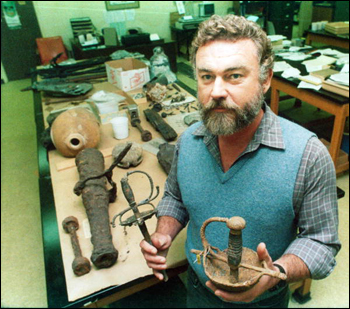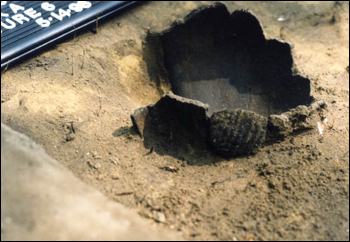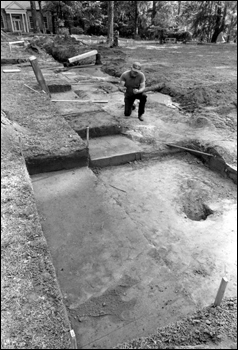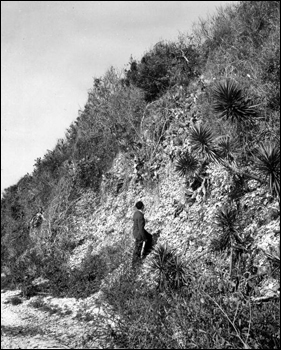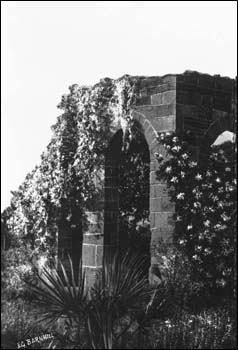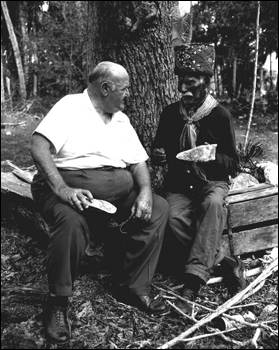Photo Exhibits
Photo exhibits spotlight various topics in Florida history, and are accompanied by brief text intended to place selected materials in historical context.
Florida Archaeology
Studying and Exploring 12,000 Years of Floridians
State Archaeology Month
In celebration of Florida Archaeology Month, this exhibit showcases images of the archaeological resources throughout the state and the professionals, enthusiasts and amateurs that have explored, preserved, and interpreted the archaeological record in order to better understand Florida's millennia of human occupation.
Held each March, Florida Archaeology Month encourages Floridians and visitors to learn more about the archaeological resources and the long cultural history of the state. In addition, the event promotes a better understanding of the important work of archaeologists, museum professionals, state park rangers and the many others that uncover, research, interpret, and protect the state's archaeological resources and help preserve these integral parts of Florida's rich cultural heritage. Visit the Florida Bureau of Archaeological Research for more information about Archaeology Month events and the state's efforts to interpret and preserve archaeological sites.
The Florida Department of Environmental Protection is also celebrating Archaeology Month at the numerous state parks that contain preserved archaeological resources.
Roger Smith, the State Archaeologist stands with some artifacts: Tallahassee, Florida (1987)
Image Number: MF0227
Remains of a ceramic vessel and shell dipper being uncovered during the University of North Florida's Sarabay Spanish Mission archaeological field school excavation on Big Talbot Island State Park: Jacksonville, Florida (1998)
Image Number: PR24730
In Spring 1998, UNF professor Dr. Robert Thunen, Keith Ashley, and Vicki Rolland conducted an archaeological survey of the southern third of Big Talbot Island. From that survey, they identified the site of 17th century Spanish mission Sarabay (the original name of the island), which was located within a Timucuan Indian village. In June 1998, they conducted the first of several excavations at the mission site using UNF students as volunteers. The photographer, a ranger at the park, was one of those volunteers.
People have made Florida their home for more than 12,000 years. Archaeological sites in the state relate to millennia of pre-historic and historic eras of human activity. From the tools and fire pits left by the first Stone Age hunter gatherers, Florida archaeology illustrates the emergence of numerous complex Native American cultures, 16th century European exploration, centuries of imperial territorial claims changing hands, and nearly two hundred years as part of the United States, from territorial settlement, the Seminole Wars, the Civil War and generations of social and economic changes.
State archaeologist Calvin Jones excavating Hernando Desoto's 1539 winter encampment : Tallahassee, Florida (1987)
Image Number: RC13647
State Archaeologist, Calvin Jones at the site where DeSoto and his army spent the winter of 1539. Jones received permission to check the site prior to some construction and found pottery, coins, chain mail, pig bones, and beads that identified the site. At the time of this photo, this was the only verified site for the entire DeSoto expedition. The site became a state park after the state purchased the site in 1988.
A man looking up to the Turtle Mound shell midden (195-)
Image Number: RC21003
The famous shell mound 7 miles south of New Smyrna Beach covers 16 acres.
Underwater archaeology is an area of particular expertise in Florida. In the hundreds of miles of fresh water and vast expanse of Florida coast, explorers and scientists have discovered fossils and artifacts covering eons, from the last Ice Age to World War II. With the state's long history of ocean exploration, pirating, and commercial shipping, Florida has been the epicenter for American treasure hunting. The exhibit also includes selections from the McKee Collection, the photographic record of the remarkable career of famous treasure hunter and museum founder, Art McKee.
Close-up of building at the New Smyrna Sugar Mill Ruins State Historic Site : Volusia County, Florida (192-)
Image Number: PHA129
The sugar mill was also known as the Cruger and DePeyster Sugar Mill. Built sometime between 1825 and 1835, it was destroyed by Seminole Indians during the Second Seminole War in the 1830s.Before coming under control of the Florida Park Service as a Historic Site, the property was mistakenly thought by many to be the ruins of a Spanish mission for the Timucua Indians, Mission of Atocuimi. The site, which was located at 600 Old Mission Road, was listed on the National Register of Historic Places on 12 August 1970.
Billy Bowlegs III telling Albert DeVane where he found ancient Indian artifacts while preparing to plant his garden (1962)
Image Number: FN0122b

 Listen: The Folk Program
Listen: The Folk Program